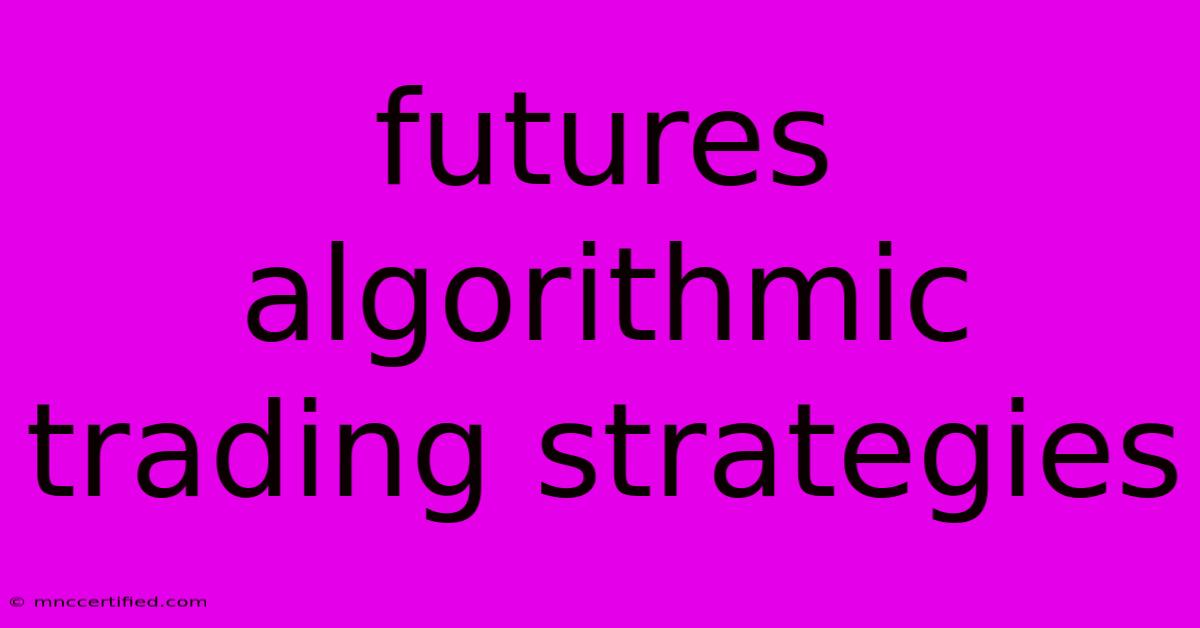Futures Algorithmic Trading Strategies

Table of Contents
Unleashing the Power of Automation: Futures Algorithmic Trading Strategies
The futures market, known for its high leverage and volatility, presents a unique landscape for traders seeking to capitalize on price movements. While traditional manual trading relies heavily on intuition and experience, futures algorithmic trading leverages the power of automation and data analysis to execute trades with precision and speed. This approach allows traders to implement strategies with complex logic, analyze vast amounts of data in real-time, and capitalize on market opportunities with minimal human intervention.
The Appeal of Algorithmic Trading in Futures Markets
Why are futures traders turning to algorithms? The answer lies in the numerous advantages they offer:
- Increased Efficiency: Algorithmic trading automates trading decisions and execution, freeing up traders to focus on strategy development and market analysis.
- Reduced Emotional Bias: By removing human emotion from the trading process, algorithms eliminate impulsive decisions and improve discipline.
- Faster Execution: Algorithms can react to market changes in milliseconds, allowing traders to capitalize on fleeting opportunities.
- Scalability and Flexibility: Automated strategies can handle a large number of trades simultaneously, allowing traders to scale their operations.
- Data-Driven Decisions: Algorithms can analyze vast quantities of data, identifying patterns and trends that human traders may miss.
Types of Futures Algorithmic Trading Strategies
While the specific implementation may vary, futures algorithmic trading strategies can be broadly categorized based on their underlying logic:
1. Trend Following Strategies
These strategies aim to capitalize on existing trends in the market. Common examples include:
- Moving Average Crossover: This strategy involves identifying buy and sell signals based on the intersection of two moving averages.
- Breakout Strategies: Algorithms identify and execute trades when prices break above or below specific resistance or support levels.
2. Mean Reversion Strategies
These strategies exploit the tendency of prices to revert to their historical average. Popular examples include:
- Pairs Trading: This strategy involves identifying two correlated assets and exploiting temporary price discrepancies.
- Channel Breakout Strategies: Algorithms identify trades when prices move beyond predefined price channels.
3. Arbitrage Strategies
These strategies aim to profit from temporary price discrepancies between different markets or instruments. Common examples include:
- Calendar Spread Arbitrage: This strategy involves exploiting price differences between futures contracts with different maturity dates.
- Intermarket Arbitrage: This strategy seeks to capitalize on price discrepancies between related assets in different markets.
Key Considerations for Implementing Futures Algorithmic Trading
While algorithmic trading offers significant advantages, it's essential to consider the following factors before embarking on this journey:
- Backtesting and Optimization: Thoroughly backtest your strategies on historical data to evaluate their performance and identify potential flaws.
- Risk Management: Implement robust risk management techniques to limit potential losses.
- Code Quality and Testing: Ensure your code is free of errors and thoroughly tested to prevent unexpected failures.
- Market Monitoring and Adjustments: Regularly monitor your strategies and make adjustments based on market conditions and performance.
- Choosing the Right Brokerage: Opt for a brokerage that supports algorithmic trading and provides the necessary tools and infrastructure.
Conclusion: Navigating the Future with Automation
Futures algorithmic trading presents a powerful tool for sophisticated traders seeking to enhance their performance and exploit market opportunities. By leveraging the power of automation, data analysis, and advanced strategies, traders can navigate the volatile futures market with greater precision and efficiency. However, it's crucial to approach this approach with thorough preparation, robust risk management, and a deep understanding of the underlying principles. By mastering these strategies, traders can unlock the full potential of automation and gain a competitive edge in the exciting world of futures trading.

Thank you for visiting our website wich cover about Futures Algorithmic Trading Strategies. We hope the information provided has been useful to you. Feel free to contact us if you have any questions or need further assistance. See you next time and dont miss to bookmark.
Featured Posts
-
Dwp Christmas Bonus Claim Your Payment
Nov 09, 2024
-
Irelands Scrums Benefit And Burden
Nov 09, 2024
-
Do Naturopathic Doctors Take Insurance
Nov 09, 2024
-
Funded Profits Trading Academy Reviews
Nov 09, 2024
-
Mike Tyson And Jake Paul Chibi Nfts Launch
Nov 09, 2024